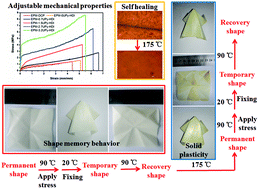Exploring multiple functions of diarylsemipinacol linked to the saturated ethylene–propylene elastomer: from the dynamic covalent networks to tailoring its macroscopic performance†
Abstract
In this paper, the commercially available ethylene–propylene elastomer (EPM) was attached to diarylsemipinacol (DASP) in the presence of benzophenone under UV irradiation. Through the multiple functions of DASP, we prepared a mechanically robust and healable EPM with shape memory properties, by integrating self-associating ureidopyrimidinone (UPy) into the dynamic covalent networks. Hence, UPy dimers with quadruple hydrogen bonds were introduced into the EPM by modifying the DASP group, whereby the macroscopic performance of the EPM derivatives, including their mechanical properties and additional shape memory behaviors, induced by the UPy dimers could be effectively tailored. Typically, the high content of UPy dimers could increase the mechanical performance and the shape fixing ability of the EPM derivatives. Dual-exchangeable bonds (urethane bonds, the bonds between diarylsemipinacol groups and elastomer chains) can impart the elastomers with self-healing properties and plasticity in solid state, which in combination with shape memory behaviors provide an increasingly powerful tool for preparing geometrically complex shapes. All in all, this combination of improved mechanical performance, self-healing and shape memory behavior can expand the scope of the applications of EPM.



 Please wait while we load your content...
Please wait while we load your content...